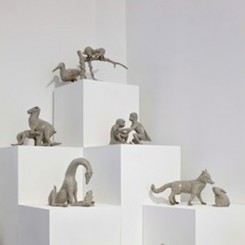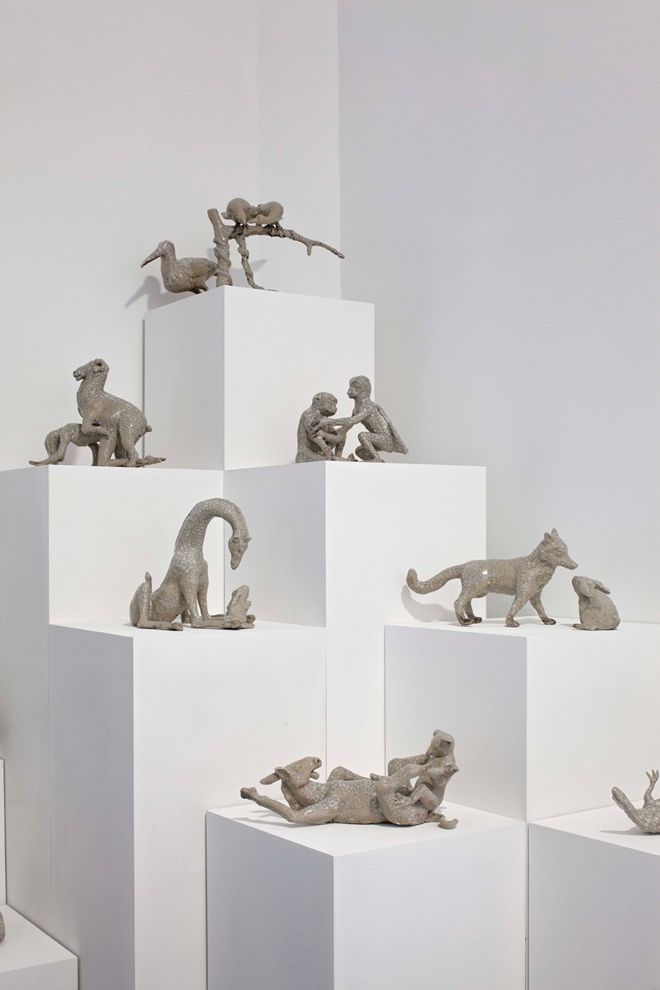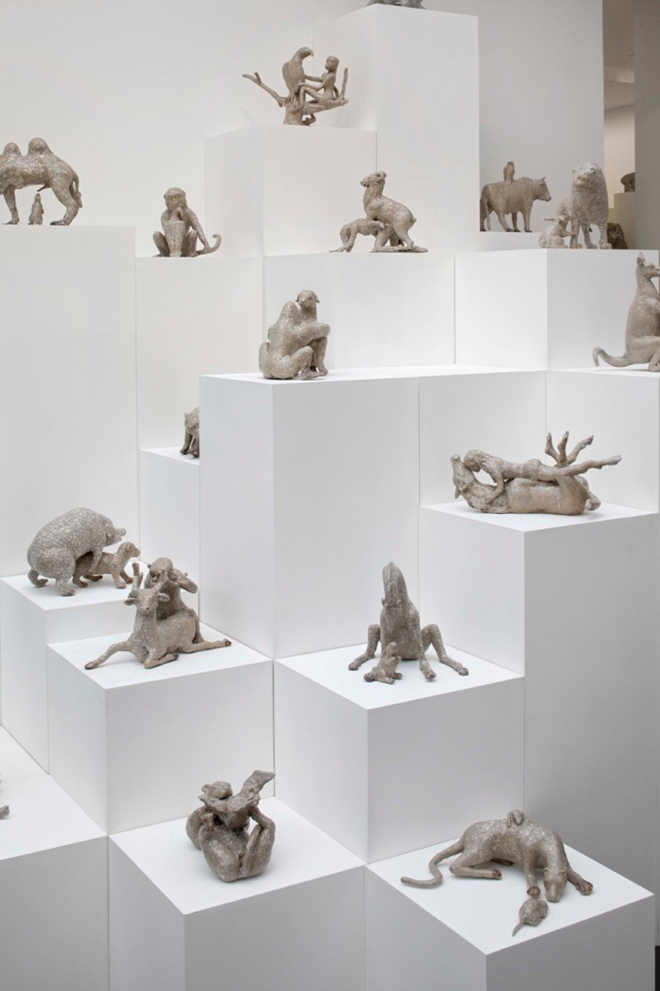There was strict discipline on the ark…Remember; this was a long and dangerous voyage — dangerous even though some of the rules had been fixed in advance. Remember too that we had the whole of the animal kingdom on board; would you have put the cheetahs within springing distance of the antelope? A certain level of security was inevitable…It wasn’t a nature reserve, that ark of ours; at times it was more like a prison ship.
…in Year Two, when the rules had been just a little relaxed…selected travelers were allowed to mingle. Well, Noah caught the ass trying to climb up the mare. He really hit the roof, ranted away about no good coming of such a union ― which rather confirmed our theory about his horror of cross-breeding ― and said he would make an example of the beast. So they tied his hooves together, slung him over the side, dragged him underneath the hull and up the other side in a stampeding sea. Most of us put it down to sexual jealousy, as simple as that.
― Julian Barnes, from A History of the World in 10½ Chapters (1)
In his series Stranger than Paradise, Yang Jiechang brings together a range of technically contrasting artworks, including a number of Chinese style ink and brush paintings on silk, a multi-tiered installation of 200 crackle-glazed ceramic sculptures and a video projection, all of which either represent or relate to an imaginary scene in which animals and people are depicted engaging freely and openly in sexual activity with one another within an idyllic pastoral setting. According to the artist, the imaginary scene of unrestrained sexuality at the centre ofStranger than Paradise is intended as an “11th day” supplement to Boccaccio’s epic poem theDecameron in which all divides―whether religious, ethnic, ideological or political―and their attendant conflicts have been symbolically suspended. As the artist has also indicated, this intended meaning is informed strongly by a Daoist-influenced Confucian belief in a fundamental cosmological interaction/reciprocity between otherwise opposing states of being (yin-yang)(2), and, by association, a traditional Chinese scholarly sense of the social, political and spiritual importance of spontaneity / self-sublimation in accordance with the way (dao)(3) of nature; otherwise referred to within the Chinese intellectual tradition as non-action (wu wei).
Set against the present day context of globalization and continuing economic and political tensions between differing localities, regions and nation states, it is therefore possible to interpret Stranger than Paradise, as Yang himself has suggested, as a critically interventionist work pointing positively towards the possibility of a natural/spontaneous (ziran)(4) global society free from prejudicial conceptions of difference. Indeed, Yang has sought to reinforce such a reading―somewhat paradoxically from a Western cultural point ofview (5)―by strongly emphasizing the unreality of the idyll represented by Stranger than Paradise(a position added to considerably by the artist’s use of a traditional Chinese non-objective “meticulous” style of painting), thereby distancing that idyll from the negativity usually associated with real-world cultural taboos against bestiality.
This authorial reading is, of course, indispensable to our understanding of Stranger than Paradise in that it gives us an insight into the thinking behind the making of the work. However, I would like to suggest here the possibility of another inter-textual/inter-cultural line of interpretation supplementing that which Yang himself has put forward; one that places the imaginary scene represented by Stranger than Paradise not simply as an extension to theDecameron, but also as an alternative to the trajectory of established Biblical narrative.

Yang Jiechang,”Stranger than Paradise – Mountain Top,” ca. 30 seconds in loop, 2010/2011 with video GONG, 2011.
In the story of Noah’s ark―versions of which appear in chapters 6-9 of the book of Genesis as well as in the surahs “Hud” and “Al-Mu’minoon” of the Qur’an, and whose origins can be traced back to an earlier Babylonian source―God looks down upon the wickedness of mankind and, sorely disappointed by his creation, decides to send a great flood to cleanse the earth. God also sees that among the whole of mankind Noah alone “remains righteous in his generation”. He therefore instructs Noah to save himself and his family by building an immense seagoing ark capable of housing “two of every sort [of animal]…male and female … everything on the dry land in whose nostrils was the breath of life”. When Noah’s family and all of the animals are safely on board and the door to the ark firmly closed, God then releases the fountains of the deep and opens up the floodgates of heaven until after six months the highest mountains are covered by water to a depth of fifteen cubits and all of the people and animals (apart from fish, marine mammals and amphibians) outside the ark are destroyed.

“Stranger than Paradise – Mountain Top,” installation of 200 ceramic sculptures realized from 100 unique
After seven months the waters of the great flood reach their highest point and over the next seven months gradually subside, eventually allowing the ark to come aground on the slopes of Mount Ararat. During the fourteenth month after the beginning of the great flood, Noah, his family and the animals then proceed to leave the ark and repopulate the earth. Upon leaving the ark, Noah raises a sacrifice to God who, for his own part, bestows on Noah and his sons the right to kill and eat the meat of animals that have been judged to be clean (the distinction between clean and unclean animals having been established, according to Judaic tradition, as the animals entered into the ark) while forbidding the eating of meat that has not been drained entirely of its blood. God also proclaims that blood will henceforth be sacred and that unlawful killing forbidden, stating that “For your lifeblood I will require a reckoning: from every beast I will require it and from man…Whoever sheds the blood of man, by man shall his blood be shed, for God made man in his own image.” In addition to all of which, God establishes a covenant with Noah, his family and the animals stating that he will never again send a great flood to destroy the earth, accepting that “the intention of man’s heart is evil from his youth”. God then places a rainbow in the sky as “the sign of the covenant that I have established between me and all flesh that is on the earth”. As such, the story of Noah’s ark has been interpreted within a Christian scholarly context as a symbolic precursor to the later coming of Christ, whose crucifixion and taking on of all human sins is intended to obviate the need for further acts of sacrificial violence as part of divine worship.
According to the “Sanhedrin,” one of theTractates (volumes) of the collection of scholarly rabbinical interpretations of Jewish law and tradition known as the Talmud (200-500 AD), the animals housed in the ark were the very best of their kind and behaved with exceptional restraint, staying celibate throughout the entire duration of the ark’s voyage. As a consequence, it is said that the number of animals that left the ark at the end of the great flood remained exactly the same as the number that had entered into it. In light of this rabbinical gloss, the ark can thus be interpreted not simply as a safe repository for the residual (genetic) goodness in God’s creation sectioned off from the greater part that had degenerated inexorably into wickedness, but as a clearly delineated space subject to a divinely inspired and rigidly observed sense of order.

“Tale of the 11th Day — Mid Autumn” (“第十一日的传说-中秋”) ink and mineral colors on silk mounted on paper and canvas, 265 x 284 cm, 2011.
Not only was God’s creation distilled down among the animals to its most basic dualistic components: a pairing of a single male with a single female (although one Rabbinical midrash claims that the unclean animals entered the ark in twos, while the clean were in sevens), there was also maintenance of the perfection of that essential binary order, both within and between animal species, through complete sexual abstinence.
Consequently, while God, in the wake of the great flood, comes to accept the inherent tendency of humanity towards evil, he does so on the basis that the earth’s new postdiluvian phase has at least been started from a renewed position of structural perfection (an extraordinarily restrictive and somewhat improbable state of affairs, played on to great comic effect by the writer Julian Barnes in “The Stowaway,” the first chapter of his bookA History of the World in 10½ Chapters). What is more, God can be understood to have employed this renewed position of structural perfection as a platform upon which to establish new legalistic constraints limiting the worst excesses of humanity’s inherent tendency towards evil.
One might, then, with some justification put forward the view that Yang’s work presents us not just with a supplement to the Decameron, but, in addition, a heretical alternative to the trajectory of established Biblical narrative in which the animals and humans housed by the ark upon reaching dry land give way, in a moment of unrestrained eroticism, to all of their pent up bodily desires, thereby initiating a new world (dis)order entirely without the categorical limits imposed by rationalist Christian morality after the Fall. Seen in these historicizing terms, the idyll represented by Stranger than Paradise can therefore be viewed as the site of a seminal moment of orgiastic (Sadian) moral transgression that nevertheless carries with it the traces of a former state of earthly conformity to the divine (a paradise lost) where there was also no clear distinction between good and evil or conception of sin. A moment that could, indeed, be said to be “stranger than paradise”.



